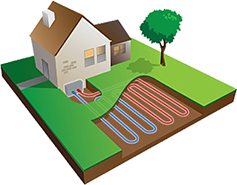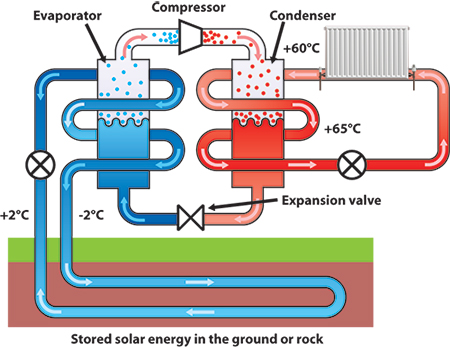Ground Source Heat Pumps
- CPCE design and install Ground Source Heat Pumps systems
- Very efficient, energy-saving systems
- Can be up to four times more efficient than heating with gas
- Qualifies for RHI (Renewable Heat Incentive) – conditions apply
- Work extremely well with under-floor heating systems
- Installed with external underground pipe-work laid in trenches or boreholes
- Planning permission may be required
A ground source Heat Pump works much like a fridge. The system is composed of the Heat Pump itself and a series of loops buried in the ground either in horizontal trenches or in a borehole some 120-meters deep. The temperature in the ground is always a steady 10 degrees centigrade or more. What a heat pump system doesn’t do is simply transfer heat from the ground to your home or business. It’s a little more sophisticated than that.
A heat pump consists of a compressor and is filled with a refrigerant, which effectively boils from a liquid to a gas at 0 degrees centigrade.
The energy from the ground is taken to heat the refrigerant to above its boiling point. The reason for this is that it takes far more energy to raise the temperature of the refrigerant – say from minus 2 to 2 degrees centigrade – than to raise the temperature from 2 to 55-degrees centigrade.
 So, the first operation is performed by transferring heat from the ground, and the second relatively lower cost operation is performed by the compressor that compresses the refrigerant and raises the temperature of the refrigerant high enough to heat the water and provide enough heat for heating.
So, the first operation is performed by transferring heat from the ground, and the second relatively lower cost operation is performed by the compressor that compresses the refrigerant and raises the temperature of the refrigerant high enough to heat the water and provide enough heat for heating.
The cost effectiveness of the system depends on how well it is designed. The property must be well enough insulated and efficient enough to ensure that installing a heat pump is cost effective. Much existing housing would not be suitable unless adequate measures are taken to improve the efficiency of the property.


